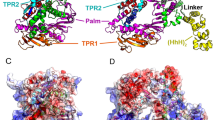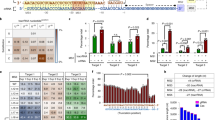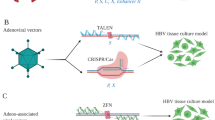Abstract
The DNA-packaging pRNA of bacterial virus phi29, which forms dimers and then hexamers, contains two independent tightly self-folded domains. Circularly permuted pRNAs were constructed without impacting pRNA folding. Connecting the pRNA 5′/3′ ends with variable sequences did not disturb its folding and function. These unique features, which help prevent two common problems – exonuclease degradation and misfolding in the cell, make pRNA an ideal vector to carry therapeutic RNAs. A pRNA-based vector was designed to carry hammerhead ribozymes that cleave the hepatitis B virus (HBV) polyA signal. The chimeric HBV-targeting ribozyme was connected to the pRNA 5′/3′ ends as circularly permuted pRNA. Two cis-cleaving ribozymes were used to flank and process the chimeric ribozyme. The hammerhead ribozyme including its two arms for HBV targeting was able to fold correctly while escorted by the pRNA. The chimeric ribozyme cleaved the polyA signal of HBV mRNA in vitro almost completely. Cell culture studies showed that the chimeric ribozyme was able to enhance the inhibition of HBV replication when compared with the ribozyme not escorted by pRNA, as demonstrated by Northern blot and e-antigen assays. pRNA could also carry another hammerhead ribozyme to cleave other RNA substrate. These findings suggest that pRNA can be used as a vector for imparting stability to ribozymes, antisense, and other therapeutic RNA molecules in vivo.
This is a preview of subscription content, access via your institution
Access options
Subscribe to this journal
Receive 12 print issues and online access
$259.00 per year
only $21.58 per issue
Buy this article
- Purchase on Springer Link
- Instant access to full article PDF
Prices may be subject to local taxes which are calculated during checkout








Similar content being viewed by others
References
Guerrier-Takada C et al. The RNA moiety of ribonuclease P is the catalytic subunit of the enzyme. Cell 1983; 35: 849–857.
Macnaughton TB, Wang YJ, Lai MM . Replication of hepatitis delta virus RNA: effect of mutations of the autocatalytic cleavage sites. J Virol 1993; 67: 2228–2234.
Pyle AM, Cech TR . Ribozyme recognition of RNA by tertiary interactions with specific ribose 2′-OH groups. Nature 1991; 350: 628–631.
Kruger K et al. Self-splicing RNA: autoexcision and autocyclization of the ribosomal RNA intervening sequence of Tetrahymena. Cell 1982; 31: 147–157.
Burgin AB, Pace NR . Mapping the active site of ribonuclease P RNA using a substrate containing a photoaffinity agent. EMBO J 1990; 9: 4111–4118.
Forster AC, Symons RH . Self-cleavage of plus and minus RNAs of a virusoid and a structural model for the active sites. Cell 1987; 49: 211–220.
Luo G et al. A specific base transition occurs on replicating hepatitis delta virus RNA. J Virol 1990; 64: 1021–1027.
Chowrira BM, Berzal-Herranz A, Burke JM . Novel guanosine requirement for catalysis by the hairpin ribozyme. Nature 1991; 354: 320–322.
Cotten M, Birnstiel M . Ribozyme mediated destruction of RNA in vivo. The EMBO J 1989; 8: 3861–3866.
Sarver NA et al. Ribozymes as potential anti-HIV-1 therapeutic agents. Science 1990; 247: 1222–1225.
He YK, Lu CD, Qi GR . In vitro cleavage of HPV16 E6 and E7 RNA fragments by synthetic ribozymes and transcribed ribozymes from RNA-trimming plasmids. FEBS Lett 1993; 322: 21–24.
Huang Y et al. Stable expression of anti-HPV 16 E7-ribozyme in CV-1 cell lines. Chin J Biotechnol 1996; 12: 215–220.
Liu B, Tabler M, Tsagris M . Episomal expression of a hammerhead ribozyme directed against plum pox virus. Virus Res 2000; 68: 15–23.
Han S et al. Ribozyme-mediated resistance to rice dwarf virus and the transgene silencing in the progeny of transgenic rice plants. Transgenic Res 2000; 9: 195–203.
Lee NS et al. Functional colocalization of ribozymes and target mRNAs in Drosophila oocytes. FASEB J 2001; 15: 2390–2400.
Kashani-Sabet M et al. Identification of gene function and functional pathways by systemic plasmid-based ribozyme targeting in adult mice. Proc Natl Acad Sci USA 2002; 99: 3878–3883.
Merlo AO et al. Ribozymes targeted to stearoyl-ACP delta9 desaturase mRNA produce heritable increases of stearic acid in transgenic maize leaves. Plant Cell 1998; 10: 1603–1622.
Perriman H, Bruening G, Dennis E, Peacock W . Effective ribozyme delivery in plant cells. Proc Natl Acad Sci USA 1995; 92: 6175–6179.
Bertrand E et al. The expression cassette determines the functional activity of ribozymes in mammalian cells by controlling their intracellular localization. RNA 1997; 3: 75–88.
Vaish NK, Kore AR, Eckstein F . Recent developments in the hammerhead ribozyme field. Nucleic Acids Res 1998; 26: 5237–5242.
Guo P, Erickson S, Anderson D . A small viral RNA is required for in vitro packaging of bacteriophage phi29 DNA. Science 1987; 236: 690–694.
Hoeprich S, Guo P . Computer modeling of three-dimensional structure of DNA-packaging RNA(pRNA) monomer, dimer, and hexamer of Phi29 DNA packaging motor. J Biol Chem 2002; 277: 20794–20803.
Garver K, Guo P . Boundary of pRNA functional domains and minimum pRNA sequence requirement for specific connector binding and DNA packaging of phage phi29. RNA 1997; 3: 1068–1079.
Chen C, Guo P . Magnesium-induced conformational change of packaging RNA for procapsid recognition and binding during phage phi29 DNA encapsidation. J Virol 1997; 71: 495–500.
Mat-Arip Y et al. Three-dimensional interaction of Phi29 pRNA dimer probed by chemical modification interference, Cryo-AFM, and cross-linking. J Biol Chem 2001; 276: 32575–32584.
Zhang C, Trottier M, Chen C, Guo P . Chemical modification patterns of active and inactive as well as procapsid-bound and unbound DNA-packaging RNA of bacterial virus Phi29. Virology 2001; 281: 281–293.
Trottier M et al. Probing the structure of monomers and dimers of the bacterial virus phi29 hexamer RNA complex by chemical modification. RNA 2000; 6: 1257–1266.
Zhang CL, Tellinghuisen T, Guo P . Conformation of the helical structure of the 5′/3′ termini of the essential DNA packaging pRNA of phage phi29. RNA 1995; 1: 1041–1050.
Zhang CL, Lee C-S, Guo P . The proximate 5′ and 3′ ends of the 120-base viral RNA (pRNA) are crucial for the packaging of bacteriophage phi29 DNA. Virology 1994; 201: 77–85.
Zhang CL, Tellinghuisen T, Guo P . Use of circular permutation to assess six bulges and four loops of DNA-packaging pRNA of bacteriophage phi29. RNA 1997; 3: 315–322.
Reid RJD, Zhang F, Benson S, Anderson D . Probing the structure of bacteriophage phi29 prohead RNA with specific mutations. J Biol Chem 1994; 269: 18656–18661.
Wichitwechkarn J, Johnson D, Anderson D . Mutant Prohead RNAs in vitro packaging of bacteriophage phi29 DNA-gp3. Mol Biol 1992; 223: 991–998.
Reid RJD, Bodley JW, Anderson D . Characterization of the prohead-pRNA interaction of bacteriophage phi29. J Biol Chem 1994; 269: 5157–5162.
Zhang CL, Garver K, Guo P . Inhibition of phage phi29 assembly by antisense oligonucleotides targeting viral pRNA essential for DNA packaging. Virology 1995; 211: 568–576.
Trottier M, Guo P . Approaches to determine stoichiometry of viral assembly components. J Virol 1997; 71: 487–494.
Trottier M, Zhang CL, Guo P . Complete inhibition of virion assembly in vivo with mutant pRNA essential for phage phi29 DNA packaging. J Virol 1996; 70: 55–61.
Chen C, Sheng S, Shao Z, Guo P . A dimer as a building block in assembling RNA. A hexamer that gears bacterial virus phi29 DNA-translocating machinery. J Biol Chem 2000; 275: 17510–17516.
Zhang CL, Trottier M, Guo PX . Circularly permuted viral pRNA active and specific in the packaging of bacteriophage phi29 DNA. Virology 1995; 207: 442–451.
Guo P . Structure and function of phi29 hexameric RNA that drive viral DNA packaging motor: review. Prog Nucl Acid Res Mol Biol 2002; 72: 415–472.
Feng Y, Kong Y, Wang Y, Qi G . Antiviral activity of a hammerhead ribozyme against HBV in HepG2.2.15 cells. Sheng Wu Hua Xue Yu Sheng Wu Wu Li Xue Bao (Shanghai) 2002; 34: 204–208.
Feng Y, Kong YY, Wang Y, Qi GR . Inhibition of hepatitis B virus by hammerhead ribozyme targeted to the poly(A) signal sequence in cultured cells. Biol Chem 2001; 382: 655–660.
Chen C, Zhang C, Guo P . Sequence requirement for hand-in-hand interaction in formation of pRNA dimers and hexamers to gear phi29 DNA translocation motor. RNA 1999; 5: 805–818.
Guo P et al. Inter-RNA interaction of phage phi29 pRNA to form a hexameric complex for viral DNA transportation. Mol Cell 1998; 2: 149–155.
Zhang F et al. Function of hexameric RNA in packaging of bacteriophage phi29 DNA in vitro. Mol Cell 1998; 2: 141–147.
Hendrix RW . Bacteriophage DNA packaging: RNA gears in a DNA transport machine (Minireview). Cell 1998; 94: 147–150.
Tuerk G, Gold L . Systematic evolution of ligands by exponential enrichment: RNA ligands to bacteriophage T4 DNA ploymerase. Science 1990; 249: 505–510.
Ellington AD, Szostak JW . In vitro selection of RNA molecules that bind specific ligands. Nature 1990; 346: 818–822.
Ciesiolka J, Gorskl J, Yarus M . Selection of an RNA domain that binds Zn++. RNA 1995; 1: 538–550.
Kraus E, James W, Barclay AN . Cutting edge: novel RNA ligands able to bind CD4 antigen and inhibit CD4+ T lymphocyte function. J Immunol 1998; 160(11): 5209–5212.
Wang C, Jin YX, Wang DB . Selection with SELEX method of small RNA molecules specifically binding to starch. Sheng Wu Hua Xue Yu Sheng Wu Wu Li Xue Bao (Shanghai) 1998; 30: 402–404.
Sayer N, Ibrahim J, Turner K, Tahiri-Alaoui A, James W . Structural characterization of a 2′F-RNA aptamer that binds a HIV-I SU glycoprotein, gp120. Biochem Biophys Res Commun 2002; 293(3): 924–931.
Bailey S et al. Phylogenetic analysis and secondary structure of the Bacillus subtilis bacteriophage RNA required for DNA packaging. J Biol Chem 1990; 265: 22365–22370.
Pecenkova T et al. Bacteriophage B103: complete DNA sequence of its genome and relationship to other Bacillus phages. Gene 1997; 199: 157–163.
Wichitwechkarn J, Bailey S, Bodley JW, Anderson D . Prohead RNA of bacteriophage phi29: size, stoichiometry and biological activity. Nucleic Acids Res 1989; 17: 3459–3468.
Shu D, Guo P . A Viral RNA that binds ATP and contains a motif similar to an ATP-binding aptamer from SELEX. J Biol Chem 2003; 278(9): 7119–7125.
Acknowledgements
This work was supported by NIH Grants GM59944, GM48159, and NSF Grant MCB-9723923 to Guo, a Grant G1999054105 from The Basic Research Program of the Ministry of Science and Technology of China to Wang. Hoeprich was supported by a Purdue University Presidential Scholarship and Showalter Foundation grant. We thank Dr Elikplimi Asem and Dr Harm Hogenesch for their comments, Jane Kovach, and Jeremy Hall for their assistance in the preparation of this manuscript.
Author information
Authors and Affiliations
Rights and permissions
About this article
Cite this article
Hoeprich, S., Zhou, Q., Guo, S. et al. Bacterial virus phi29 pRNA as a hammerhead ribozyme escort to destroy hepatitis B virus. Gene Ther 10, 1258–1267 (2003). https://doi.org/10.1038/sj.gt.3302002
Received:
Accepted:
Published:
Issue Date:
DOI: https://doi.org/10.1038/sj.gt.3302002
Keywords
This article is cited by
-
Photo-controlled release of paclitaxel and model drugs from RNA pyramids
Nano Research (2019)
-
Effect of single-residue bulges on RNA double-helical structures: crystallographic database analysis and molecular dynamics simulation studies
Journal of Molecular Modeling (2017)
-
Specific Delivery of MiRNA for High Efficient Inhibition of Prostate Cancer by RNA Nanotechnology
Molecular Therapy (2016)
-
Hairpin Ribozyme Genes Curtail Alcohol Drinking: from Rational Design to in vivo Effects in the Rat
Molecular Therapy - Nucleic Acids (2016)
-
Fabrication of pRNA nanoparticles to deliver therapeutic RNAs and bioactive compounds into tumor cells
Nature Protocols (2013)



